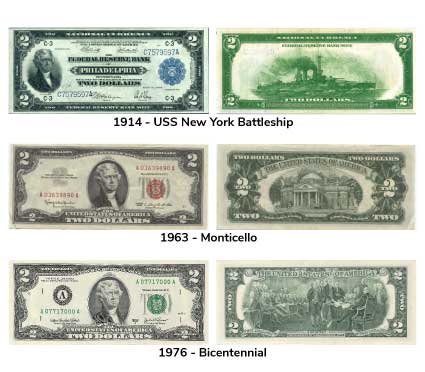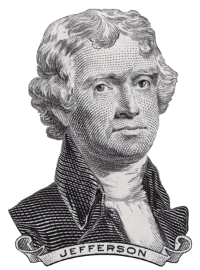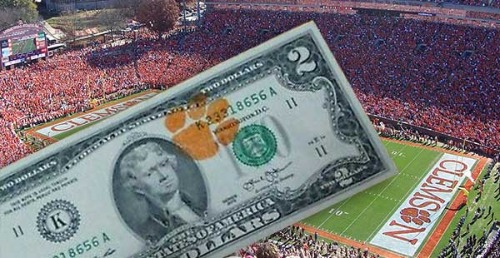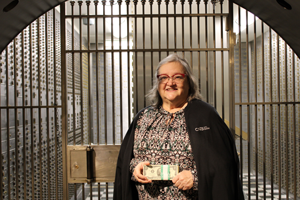The Infamous Two-Dollar Bill
By: Mary Piles, CNB St. Louis Bank Historian
Posted: February 22, 2022
Two’s Day Two-Twenty-Two-Twenty-Two (2-22-2022)
In honor of Two’s Day, we encourage you to spend a $2 bill, also known as a "Tom!" While the $2 bill is in circulation today, it has always been somewhat scarce. Therefore, presenting a $2 bill for payment may elicit confusion, nostalgia, or even a smile or happy story!
Fun Facts about the Two-Dollar Bill
- Nicknamed the “Tom” because they feature Thomas Jefferson’s portrait on the face
- Has been linked in the past to bribery, election rigging, gambling, prostitution, and bad luck in general
- Used by Clemson University, Geneva Steel, and 2nd Amendment proponents
- Originally printed between 1862 – 1966, then printing resumed in 1976 for the Bicentennial
- Printing $2 bills is twice as cost-effective as printing $1 notes
- Are still in circulation today and occasionally printed
Timeline and Use
 In 1862, the Federal Government began printing the very first paper bills which included the two-dollar bill. Paper money took a while to catch on, as coin was the preferred currency at the time. Considering that at the turn of the century most Americans were earning less than $15 per month, a $2 bill was a large bill at that time.
In 1862, the Federal Government began printing the very first paper bills which included the two-dollar bill. Paper money took a while to catch on, as coin was the preferred currency at the time. Considering that at the turn of the century most Americans were earning less than $15 per month, a $2 bill was a large bill at that time.Even after inflation began to bring the value of paper money down, most people preferred to use coins. From 1929 to 1941, the country experienced the longest and deepest economic downturn to date, the Great Depression. During that time, most goods and services were less than a dollar, making paper currency impractical to use.
As need and use declined over the years, the Federal Reserve stopped printing $2 bills in 1966. Ten years later, in 1976, the Federal Reserve brought back the $2-dollar bill with a new and beautiful picture depicting the presentation of the Declaration of Independence to the Continental Congress on the back of the bill. Thomas Jefferson was one of the men credited with penning the Declaration, therefore the image on the back of the new bill was very fitting. They thought the reprinting should increase the use and interest in the bill, but it had the opposite effect. Many Americans thought the newly designed bill, which was produced for the United States Bicentennial, was going to be a special printing; therefore, the bills were saved as collectors’ items – tucked away in safe deposit boxes, drawers, and keepsake boxes, for a hope of future value.
The Dirty “Tom”
One of the reasons the $2 bill was never widely circulated is thought to be due to its negative reputation.
 |
The poor “Tom” couldn’t catch a break! The public didn’t want to use these bills, so the Federal Reserve found a way to recover the cost of printing. From World War II until at least the 1980s, you could find sweet old “Tom” getting a workout in Military pay envelopes, USOs, Post Exchanges, commissaries, and wherever you find soldiers.
|
Clemson University $2 Dollar Bill Tradition and “SpendTom” Campaigns
 For many years, Clemson University Tigers and Georgia Tech Yellow Jackets had a football rivalry, playing annually in Atlanta, on the Yellow Jacket’s home turf. In 1977, Georgia Tech threatened to stop playing Clemson University. That year, Clemson University’s Athletic Fundraising Organization, called IPTAY, urged fans who made their way to Atlanta for the Tigers game to use $2 bills. The goal was to show local merchants, such as hotels and restaurants, what an impact the Clemson Tigers had on the local economy. The executive secretary of IPTAY, George Bennett, urged fans to use these rare bills for every expenditure. While the exact impact Tigers fans had on Atlanta’s economy that weekend in 1977 is unknown, the tradition was born. To this day, some Clemson fans still stock up on $2 bills, some stamped with tiger paws, when they head to an opponent’s town to let everyone know that the Tigers are in town. Learn more at https://www.youtube.com/watch?v=17150jCbxxs
For many years, Clemson University Tigers and Georgia Tech Yellow Jackets had a football rivalry, playing annually in Atlanta, on the Yellow Jacket’s home turf. In 1977, Georgia Tech threatened to stop playing Clemson University. That year, Clemson University’s Athletic Fundraising Organization, called IPTAY, urged fans who made their way to Atlanta for the Tigers game to use $2 bills. The goal was to show local merchants, such as hotels and restaurants, what an impact the Clemson Tigers had on the local economy. The executive secretary of IPTAY, George Bennett, urged fans to use these rare bills for every expenditure. While the exact impact Tigers fans had on Atlanta’s economy that weekend in 1977 is unknown, the tradition was born. To this day, some Clemson fans still stock up on $2 bills, some stamped with tiger paws, when they head to an opponent’s town to let everyone know that the Tigers are in town. Learn more at https://www.youtube.com/watch?v=17150jCbxxs This tradition is not unique to the Clemson Tigers. Some conventions and tourism bureaus also leverage the scarcity of $2 bills. By urging attendees and tourists to spend rare bills during their visits, they can illustrate the economic impact such activities have on their host communities. These types of campaigns are known as “SpendTom” campaigns.
Similarly, Geneva Steel used the $2 bill to show their economic impact by paying their employees’ bonuses with $2 bills in 1989.
Proponents of 2nd Amendment rights often use the rarely seen bills to show their support for the law.
A $2 Dollar Love Story
Originally printed in The New York Times is the Story of Myrta Gschaar and her husband, Robert. In 1980, and with a very small income, Robert couldn’t afford an engagement ring, so he and his bride-to-be exchanged $2.00 bills. They folded the bills and kept them in their wallets to remember each other’s commitment before their marriage.
Years later, Robert was a victim of the September 11 attacks. Four years after the attack, Robert's remains had yet to be recovered. The Special Property recovery unit at the Police Department notified Mrs. Gschaar that it had recovered remains at ground zero, including a wedding ring and a wallet containing a neatly folded $2.00 bill.
Get Yours!
While the $2 dollar bill has quite an interesting past, it is still in circulation and is occasionally printed. Visit one of CNB’s area branch locations today and ask for $2 bills in your change! Be sure to let your teller know if you plan to spend it or hold onto it as a keepsake. Happy Two’s Day from CNB!
About the Author

Mary Piles is the Historian and Archivist at CNB St. Louis Bank. Mary has worked at the bank since 1977 and has held a variety of roles in her 40+ years of loyal service. Piles currently serves as the receptionist at our main branch in Maplewood, MO. She was appointed as the Bank's Historian and Archivist in 2020, and since has been working diligently to research and preserve the Bank's rich history. Learn more about the Bank's 100+ year history here.
References:
- 2-72 What the Deuce? (2015, September 24). Retrieved from College of Curiosity: http://collegeofcuriosity.com/2-72-what-the-deuce/
- Andres, T. (2015, January 9). Why are there so few $2 bills? Retrieved from Marketplace: https://www.marketplace.org/2015/01/09/why-are-there-so-few-2-bills/
- Bennardo, J. (2020, April 24). The Two Dollar Bill Documentary. Retrieved from YouTube: https://www.youtube.com/watch?v=4b3TczZpC_Y
- Clemson University. (2022, February 15). The $2 Dollar Bill Tradition. Retrieved from Clemson Tigers: https://clemsontigers.com/the-2-dollar-bill-tradition/
- The New York Times. (2014, April 1). Years After 9/11, Items Returned. Retrieved from The New York Times: https://www.nytimes.com/2008/04/05/nyregion/05memorial.html
- Wikimedia Foundation, Inc. (2022, 02 15). Geneva Steel. Retrieved from Wikipedia: https://en.wikipedia.org/wiki/Geneva_Steel
- Wikimedia Foundation, Inc. (2022, February 15).United States two-dollar bill. Retrieved from Wikipedia: https://en.wikipedia.org/wiki/United_States_two-dollar_bill

